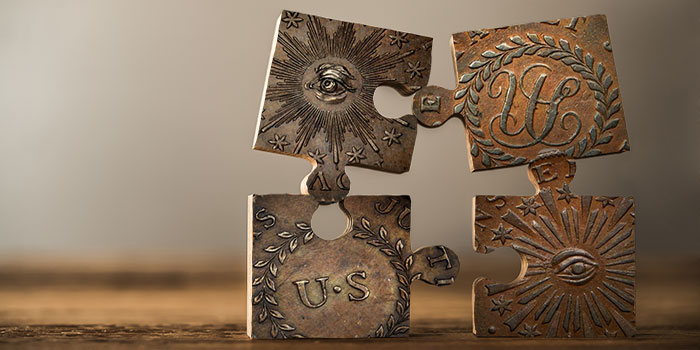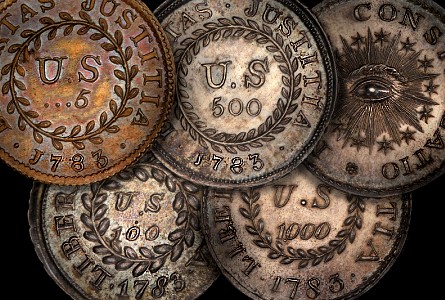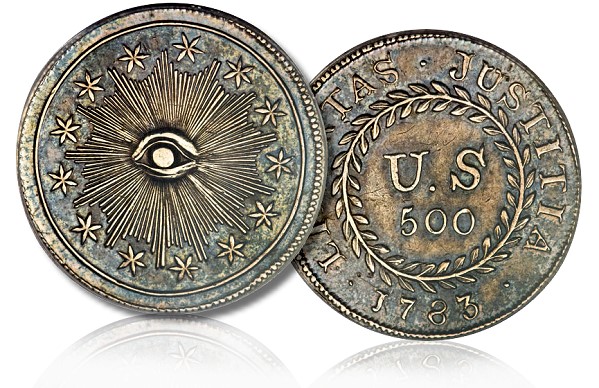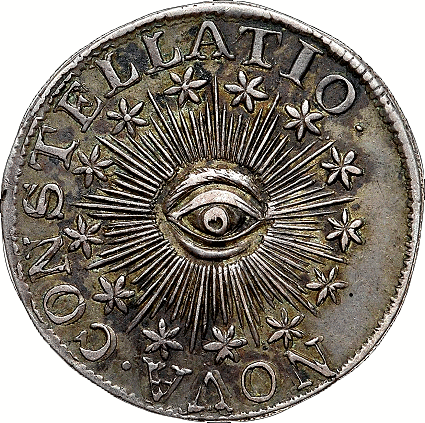
By Lianna Spurrier for CoinWeek …..
What was the first US coin? The 1793 large cent? Or the 1792 half disme?
Nope.
The first coin series minted under the authority of the US government was the Nova Constellatio series, a set of pattern coins called for by Robert Morris in 1783 with a fascinatingly convoluted backstory. Poor documentation has left us with countless mysteries to uncover about this very small set.
The Morris & Morris Plan
Young America had a remarkably complicated economy. Not only were coins from different countries circulating, but the same coins were worth drastically different amounts in different states. For example, £1 of British coins in New Hampshire was equivalent in buying power to a little over £2 in Georgia. The only standard coin was the Spanish milled dollar, though it still traded for different amounts in different states.
Congress had the authority to mint coins for the new nation starting in early 1781, when the Articles of Confederation were officially ratified. Robert Morris was appointed as the Superintendent of Finance the same year, and establishing a mint became one of his campaigns. He worked together with Gouverneur Morris (no relation) to devise a system that would divide evenly into all the circulating currencies.
They proposed this new system to Congress on January 15, 1782. It divided the dollar into 1/1440, which allowed every state but South Carolina to convert their predominant currency evenly into the new denominations without decimals. Morris argued that this would be the most convenient for merchants and consumers alike, while also helping to unify the loosely connected states. He called for the minting of silver coins worth 1,000-, 500-, and 100-units, in addition to copper 8- and 5-unit pieces.
The Timeline
On February 21, Congress approved Morris’s plan and allowed him to move forward with the establishment of a mint. He hired Benjamin Dudley, a metallurgist in Boston, to oversee operations, and, slowly but surely, a functional mint was assembled.
On April 2, 1783, Morris recorded in his diary, “I sent for Mr. Dudley who delivered me a piece of Silver Coin, being the first that has been struck as an American Coin.” According to this diary, he prodded Dudley twice in mid-April to produce more coins.
On April 17, a payment was made reimbursing John Swanwick for payments to David Tew for producing two pairs of dies, one of which must have been used to produce this first coin. On April 22, according to Morris’s diary, “Mr. Dudley sent in several Pieces of Money as patterns of the intended American Coins.” These coins were delivered to Congress the following day, and passed on to a committee who would provide a recommendation for further action.
On May 5, Abraham Dubois was paid for engraving four pairs of dies.
Over two months later, on August 5, the committee recommended to Congress that Morris prepare a report outlining the costs of establishing a full mint that would be capable of producing coins for circulation. This report was entered and read, but no further action was taken, effectively ending Morris’s dream of establishing a mint.
The majority of the set delivered to Congress soon came into Thomas Jefferson’s possession, who recorded its value as “1.8 D” and passed it on the Charles Thomson, secretary of the first Congress.
Dudley was paid for his work and Morris encouraged him to find work in the private sector. Soon after, in 1784, Thomas Jefferson proposed a new plan based on a dollar divided into 1/100. As complicated as Morris’s plan was, it was the first decimal coinage system conceived and served as the basis of Jefferson’s proposal. This new system was approved and led to the first circulating coins in 1793.
But this was far from the end of the saga of Morris’s mint. It would take almost 200 years to find all of the pieces he minted, and longer to figure out which was the singular first coin from April 2.
Finding the Constellation
A descendant of Charles Thomson found two of Morris’s coins tucked in a secret compartment of Thomson’s desk: a 1,000-unit Mark and a 500-unit Quint. Both coins have very similar designs. On the obverse is an eye surrounded by a glory of rays, 13 stars, and the inscription “Nova Constellatio”. The reverse reads “Libertas” and “Justitia”, around the edge, with 1783 below. In the center is a wreath encircling “U.S” and the denomination.
 From this discovery, the series was dubbed the Nova Constellatios, as they are still known today.
From this discovery, the series was dubbed the Nova Constellatios, as they are still known today.
In October of 1870, the discovery of a third piece was announced in the Curiosity Cabinet. The article was then reprinted in the November issue of Mason’s Monthly Coin and Stamp Collectors’ Magazine, which can still be found online. It was similar to the first Quint, but lacked the Nova Constellatio legend on the obverse, which puzzled collectors for decades.
According to the magazine, it was handed down to a young man in New York by his grandfather as a family relic. The brief article incorrectly reports that it was intended to represent “500 millesimos Spanish money.”
In an 1875 publication by Sylvester S. Crosby, entitled The Early Coins of America and the Laws Governing their Issue, this Quint is identified as “Obverse Number 2” due to the missing legend. It came to be known as a Type 2.
Two 100-unit bits were found in close succession in 1885 and 1886 in Scotland and London, respectively. They both made their way back to America and eventually into the hands of two very well-known collectors: John J. Ford Jr. and Eric P. Newman. They were both made from the same dies, but one has a vine engraving on the edge and the other is plain.
A 5-unit copper piece turned up in Paris in 1977 among a collection of British colonial coins. It was soon sold to Ford as well, who then owned the only complete set of Nova Constellatio coins: the Mark, the Type 1 Quint, the decorative edge Bit, and the only 5-unit copper piece.
All six of these coins have been authenticated by either PCGS or NGC. Pedigrees are available for each of them, their current locations are known, and they’re fairly easy to find images of online.
But there’s one more coin.
Many sources claim that three Bits were found by 1900, but there were only two. The third and final Bit wasn’t publicly announced until 1991, and very little is known about it.
According to a Stack’s auction catalog, it was acquired by an Italian man in Philadelphia in the 1920s, who took it back to Italy. In 1990, one of his descendants consigned it to Stack’s, who auctioned it off in 1991 to a private New York collector. It has a vine engraving on the edge, but is significantly more worn than any of the other coins and has never been to a third party grading service.
These seven pieces account for all of the coins we know exist. Jefferson possessed “1.8 D” of Nova Constellatio coins that he gave to Thomson. Since a 1,000- and 500-unit were found in Thomson’s desk, logic dictates that there were an additional three 100-units in this grouping, giving it a total value of 1,800-units between five coins. In addition, a diary entry by Samuel Curwen in 1784 describes the 5-unit piece in detail as a gift he received, so we knew that it had been struck and separated from the set before it came into Jefferson’s possession.
As for the Type 2 Quint… well, it existed. We’ve known it existed since 1870, but no one was sure how exactly it fit in.
So Which Was It?
There were a lot of questions regarding the Type 2 Quint. It was made from the same reverse die as the Type 1, but some people believed that the obverse was engraved by someone different than the rest of the series. The rays on it are much more carefully crafted and are in matching pairs, while the rest of the coins are of a lower artistic standard and have single rays.
Of course, there was also the obvious question – why was the Nova Constellatio legend missing? David McCarthy solved the mystery in 2017. For years, numismatists had assumed that the Mark was the single coin delivered to Morris on April 2 – after all, it made sense to start with the largest denomination, right?
Wrong. According to McCarthy’s research, the ever-puzzling Type 2 Quint was the first coin – the first of the Nova Constellatios, and the first coin ever minted under the authority of the US government.

In light of this discovery, it was renamed the Plain Obverse Quint and the other as the With Legend Quint.
To prove this, we have to go back to the creation of the series. David Tew was paid for engraving two pairs of dies in mid-April, and Abraham Dubois was paid for engraving four pairs in early May. If we accept, as experts have for decades, that the Plain Obverse was engraved by someone different than the rest of the series, it would have to be Tew. He didn’t engrave enough dies to have produced the rest of the coins.
The coins themselves offer more evidence to support this. Each has a beaded border, most of which are composed of large beads. However, both sides of the Plain Obverse Quint, the reverse of the With Legend Quint, and – curiously – the reverse of all three Bits feature smaller beads. Since both Quints use the same reverse die, this means that three total dies had smaller beads. The dies would have been created using a punch, suggesting that these three were engraved at the same time. This would account for three of the four total dies that Tew engraved.
A very close inspection of the two Quints gives us further evidence to determine which was struck first. There is minor reengraving on the reverse on the lower left serif of the first I in Justitia. It shows that the die had to have struck the Plain Obverse first, been reengraved, and then struck the With Legend.
There is also evidence to suggest that the die for the Plain Obverse was ground down and reused to produce the With Legend. The With Legend Quint was struck with an obverse die slightly larger than the reverse. Dies are conically shaped, so grinding one down and reengraving it would effectively give it a slightly larger diameter. In addition, the deepest part of the design – the center of the eye – lines up between the two coins.
Putting all of this together tells us that both sides of the Plain Obverse were engraved and used to strike the coin. Then, at a later date, the With Legend obverse was engraved along with the rest of the series, with large beads, and the Quint reverse reengraved before striking the With Legend Quint.
Finally, the weight of the coin is inconsistent with Morris’s plan. The system he proposed in January of 1782 is very specific about the weights of the different coins, and the Plain Obverse Quint doesn’t follow – it’s too light. All of the other coins align very closely with the guidelines he set forth. It would make sense that it was struck to prove that Dudley’s mint was capable of producing coins, not as an example of Morris’s plan to show to Congress.
McCarthy’s research left little room for doubt that the Plain Obverse Quint is the first US coin, finally solving a 200-year-old mystery.
The Story Isn’t Finished
However, this series is still full of questions.
First of all, not all of the dies are accounted for. We know that David Tew was paid for engraving two pairs of dies. One of these was for the Plain Obverse Quint, and the bead size suggests that he also engraved the Bit reverse, which leaves one die unaccounted for.
Abraham Dubois was later paid for engraving four pairs of dies. We know that he engraved both sides of the Mark and 5-unit piece, which account for two pairs, as well as the With Legend Quint obverse and Bit obverse. This leaves one pair of dies unknown.
Could there be an 8-unit piece out there? It’s the only coin Morris’s plan called for that has never been found. However, there are also no records to indicate that one was ever struck.
 Perhaps the dies were engraved for it, but a sample was never successfully produced? We simply don’t know.
Perhaps the dies were engraved for it, but a sample was never successfully produced? We simply don’t know.
Based on payment records, only five pairs of dies were forged, meaning one pair had to have been ground down and reengraved. We know the Quint obverse was one of these, but which was the other?
In addition, only two of the three Bits have a vine engraving on the edge. Why is one left plain? And while we now know why the Plain Obverse Quint is so different from the rest, we don’t know why the Nova Constellatio legend was added between April 2 and 22.
There are still countless secrets hiding in the Nova Constellatios, and we can only hope that someday they will be uncovered. Maybe the answers are out there, buried in someone’s stash of unidentified coins or in a journal forgotten deep in an archive. However, one thing is for sure: If we don’t ask the questions, we’ll never find the answers.




